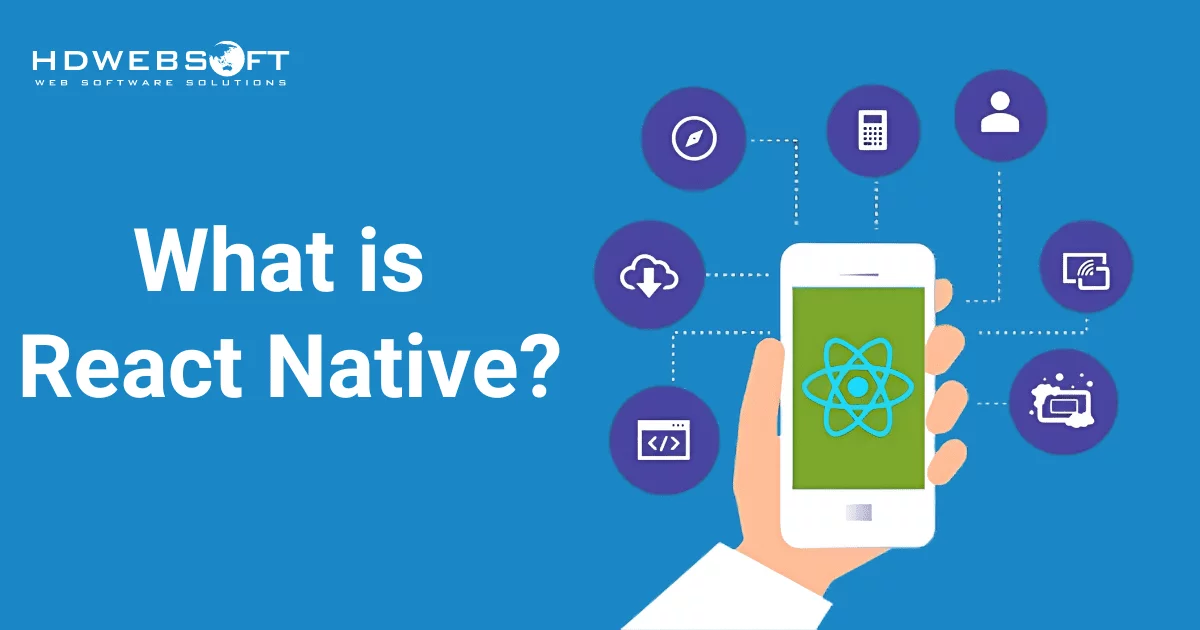
What is React Native? A Quick Guide
React Native creation has exploded in popularity in recent years. It offers a powerful and efficient way to build mobile applications using JavaScript and React. This streamlined approach offers numerous advantages, making it an attractive option for both seasoned developers and those new to the mobile app development landscape.
This quick guide will introduce you to the fundamentals of this framework, explore its key features, and discuss the common challenges associated with React Native development.
What is React Native?

React Native is a game-changer for mobile app development. This JavaScript-powered framework empowers you to build native-looking apps for both iOS and Android, all while using a single codebase. This translates to significant time and resource savings, allowing you to create applications for multiple platforms efficiently.
React Native’s journey began in 2015 when Meta released it as an open-source project. Within a short timeframe, it rapidly climbed the ranks to become one of the most sought-after solutions in mobile development.
Today, React Native creation’s influence extends to some of the world’s most recognizable mobile apps, including Instagram, Facebook, and Skype. This widespread adoption is a testament to its efficiency and ability to deliver high-quality native experiences.
How React Native Works
At the core of React Native creation is the use of JavaScript. However, the real power comes from the bridge between JavaScript and native code.
React Native uses a JavaScript thread and a native thread. The JavaScript thread is responsible for running your application logic, while the native thread handles rendering the user interface and interacting with native APIs. These threads communicate via the React Native “bridge,” which allows JavaScript code to interact with native modules seamlessly.
Rendering Native Components
One of the reasons React Native is so powerful is because of its ability to render native components. By leveraging platform-specific APIs, React Native renders UI components that users interact with as actual native components, not web views. As a result, this approach ensures the app looks and feels like a native app.
This approach ensures the app looks and feels like a native app. Whether it’s buttons, text fields, or other elements, React Native converts them into their native counterparts on iOS and Android, leading to a truly native user experience.
Declarative UI with React
React Native creation benefits from React’s declarative UI model. This model allows developers to describe how the interface should look based on the current state of the app. In simple terms, you tell React Native what you want the interface to look like, and it handles the how.
Generally, React’s component-based architecture makes it easy to break down the UI into smaller, reusable components. They significantly enhance the maintainability and scalability of applications. Every time the state of an app changes, React Native automatically updates the UI to reflect those changes, ensuring a smooth user experience.
Hot Reloading for Faster Development
One of the standout features of React Native is hot reloading. This feature enables developers to see the changes they make in real time without recompiling the entire application.
As a developer writes new code or modify existing components, they can instantly see the result reflected in the app. This drastically speeds up the development process and is especially beneficial when fine-tuning user interfaces or adjusting animations.

Hot reloading is one of the most significant features of React Native development.
Platform-Specific Code
While React Native creation allows for a shared codebase between iOS and Android, it also supports platform-specific code when necessary. In some cases, developers may need to implement features differently on each platform due to their distinct APIs or user interface guidelines.
React Native provides flexibility in handling this by allowing developers to write separate platform-specific code where required while maintaining the overall shared structure. This ensures that React Native applications can retain native performance and platform-specific features without sacrificing the benefits of cross-platform development.
Key Features of React Native
React Native offers a unique set of features that contribute to its popularity in mobile app development. Here are some of the key features:
Cross-Platform Development
Perhaps React Native’s most attractive aspect is its ability to bridge the gap between web creation and native mobile app creation. By leveraging JavaScript and React, technologies familiar to many web developers, React Native allows you to build native-looking apps for iOS and Android using a single codebase. This stands in stark contrast to traditional native app development, which often requires separate codebases and skill sets for each platform.
This unified approach offered by React Native translates to significant time and resource savings, fueling the ongoing debate between React Native and frameworks like Flutter when it comes to building cross-platform software. With React Native, you can streamline your development process, reduce costs, and focus on building a great user experience for both iOS and Android users.
JavaScript Expertise
React Native creation leverages JavaScript, a widely popular and well-understood programming language. Developers with existing JavaScript knowledge can easily transition to React Native development, reducing the learning curve.
Native Performance
Although built with JavaScript, React Native apps leverage the power of native UI components. This approach allows them to render UI elements that look and feel identical to their counterparts on iOS and Android. The result is a seamless user experience that delivers the responsiveness and performance expected from native apps.
Hot Reloading
It eliminates the need to restart the app after every code change manually. Instead, you can see your modifications reflected in the running app nearly instantaneously. It also proves invaluable for debugging. By instantly seeing the impact of code adjustments, you can pinpoint and resolve issues much faster, saving you valuable time and frustration.
Reusable Components
React Native shines in its approach to building mobile apps. It heavily promotes the use of reusable components. These pre-built UI elements act like Lego bricks for your app. The same component can be used across various screens in your app, saving you development time and effort. By using reusable components, you automatically improve your app’s maintainability and consistency.
Large Community and Ecosystem
React Native’s popularity is fueled by its vibrant developer community. Thousands of passionate developers contribute to a vast ecosystem of libraries and tools. This translates into a wealth of resources at your fingertips. No matter what functionality you’re trying to implement in your app, chances are there’s a pre-built solution or library readily available.
Open-Source and Flexibility
One of React Native’s major strengths is its open-source nature. This means that the core codebase is freely available for anyone to inspect, modify, and contribute to. This openness empowers developers with a high degree of customization and flexibility. They can access and edit the underlying code to tailor the framework to their project’s specific requirements.
Thriving Community and Ecosystem
React Native benefits from a large and active developer community. This means you have access to a wealth of resources, support forums, and pre-built libraries for various functionalities. This makes development easier and provides solutions for common challenges.
Common Challenges in React Native Creation
Performance Issues
React Native applications, particularly those with intricate UIs or extensive data handling, can experience performance issues. These can include sluggish scrolling, slow loading times, or dropped frames, negatively impacting the user experience.
Solution
To address this, developers can utilize techniques to minimize unnecessary re-renders with PureComponent or React.memo(). Use shouldComponentUpdate for granular control over updates. Manage large data efficiently with FlatList and SectionList.
Platform-Specific Bugs
Debugging React Native applications can be more intricate compared to native development due to the abstraction layer between the code and the device. Debugging tools might not always provide the same level of detail or insight.
Solution
One effective solution is to leverage Chrome DevTools’ React Native extension or specialized tools like React Native Debugger or Flipper. Strategically place console.log statements to trace variable values and execution flow.
Limited Native API Access
While React Native provides a vast array of UI components, there might be situations where specific native UI elements are not readily available. This can limit the ability to achieve a completely native look and feel for the application.
Solution
A recommended solution is to explore third-party libraries for additional native UI components. For highly specialized elements, consider creating custom native modules to interact with native platform APIs.
Complex UI Designs
Developing complex UI designs can be challenging in React Native, especially when customization beyond standard components is necessary. This challenge often requires significant effort and expertise to implement intricate interactions and designs effectively.
Solution
Prioritize performance optimization techniques. Explore third-party libraries for additional native UI components. For highly specialized elements, consider creating custom native modules to interact with native platform APIs.
When Should You Choose React Native?

React Native creation has gained immense popularity due to its ability to create cross-platform mobile applications with a single codebase. However, deciding when to use React Native depends on various factors that align with the needs of your project:
Cross-Platform Development
One of the main reasons developers opt for React Native is its cross-platform capability. If your goal is to build an app that works on both iOS and Android without maintaining separate codebases, React Native is a smart choice.
With a single codebase, this framework enables you to share a majority of the code across platforms. This approach drastically reduces the time, cost, and effort involved in creating mobile applications for both systems.
Instead of hiring separate teams for Android and iOS, you can rely on one development team to build the app. This move will help you improve collaboration and reduce project timelines.
Faster Time to Market
For startups and businesses that need to launch their product quickly, React Native creation is an excellent solution. Its cross-platform nature, combined with features like hot reloading, enables faster development cycles. Hot Reloading allows developers to see real-time changes, which cuts down on the time spent recompiling and restarting the app.
Ultimately, if your project has a tight deadline, React Native offers a much faster route than building native apps separately. Additionally, if you’re looking to bring a minimum viable product (MVP) to market quickly, React Native is an ideal solution.
Limited Budget
This JavaScript framework is often the preferred choice when budget constraints are a factor. Since you only need to develop one codebase for both Android and iOS, the overall development cost is significantly reduced. This is particularly beneficial for small and medium-sized businesses or startups that need to optimize their resources.
With React Native, you avoid the need to hire two separate development teams, which results in considerable savings in both time and money. Moreover, the ongoing maintenance costs are lower, as updates and bug fixes can be applied to both platforms simultaneously.
Native-Like Performance
Presently, businesses may want the performance of a native app without the complexities of developing and maintaining two separate versions. React Native creation bridges this gap by providing near-native performance. Specifically, the framework uses native components to render the user interface, ensuring the app feels both responsive and smooth.
If your app doesn’t require highly complex animations or platform-specific functionality, React Native will deliver performance comparable to native apps while saving development resources.
Large Developer Community and Ecosystem
React Native benefits from a large and active developer community. If your team needs support, a wealth of documentation, tutorials, and open-source libraries are available. Or better, if your project requires third-party libraries or integrations, there’s a good chance a pre-existing solution is available. As a result, these convenient solutions can significantly reduce development time, thus speeding up the whole process.
Moreover, popular tools such as Redux for state management and Expo for project setup further streamline the development process.
Future-Proofing Your App
React Native is a framework backed by Facebook and used by leading companies like Instagram, Airbnb, and UberEats. This backing ensures that React Native creation will continue to evolve and receive long-term support. If you’re looking for a stable, well-maintained framework that’s likely to stay relevant for years to come, React Native is a solid choice.
As the mobile app market evolves, React Native’s ability to stay up-to-date with the latest OS advancements makes it a future-proof solution.
Apps That Focus on User Interface
If your app focuses heavily on user interface design and requires frequent updates or testing, React Native is an ideal choice. The framework’s component-based structure makes it easy to create reusable UI elements and adjust them as needed.
With its hot reloading feature, developers can quickly test and tweak UI components without interrupting the app’s functionality. This is especially useful for businesses that rely on delivering consistent, user-friendly experiences. There are many examples, but it is particularly important for e-commerce platforms, social media apps, and content-driven services.

React Native is an ideal choice for apps that rely heavily on UI due to its hot reloading feature
Conclusion
React Native has opened a world of possibilities for developers, offering a robust framework for building beautiful and functional mobile applications that work seamlessly across both iOS and Android platforms. This quick guide has equipped you with the foundational knowledge to get started. By understanding the core features and challenges of React Native creation, you can make informed decisions when building your mobile applications.
If you want to hire React Native developers who are passionate about delivering the best software solutions for your businesses, look no further! HDWEBSOFT specializes in providing top-tier React Native development services tailored to your specific needs. Our team of skilled and experienced developers is dedicated to crafting innovative, high-performance applications that exceed your expectations. Share your vision with us!











